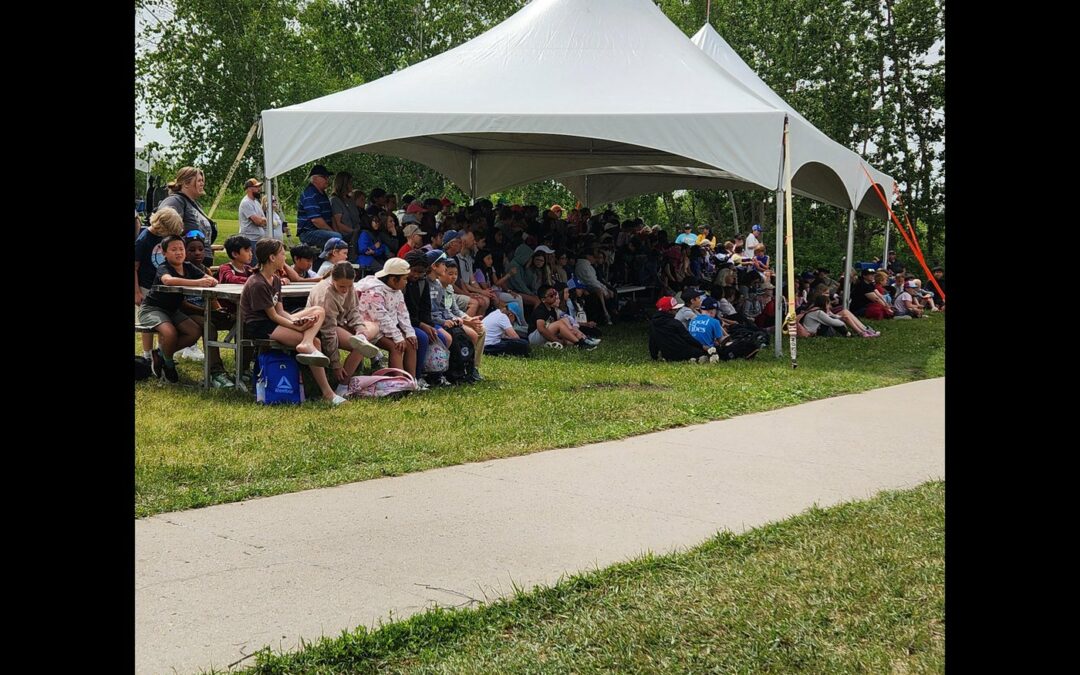Photo: School students gather at Batoche for National Indigenous Peoples Day / Carol Baldwin, Local Journalism Initiative Reporter
By Carol Baldwin
Local Journalism Initiative Reporter
Wakaw Recorder
Although Indigenous History Month is wrapping up, Batoche has stories and history that last longer than one month. National Indigenous History Month was first designated by the federal government in 2009. “National Indigenous History Month gives us the chance to celebrate Indigenous cultures and honour the many contributions of Indigenous people to this great province,” Government Relations Minister Eric Schmalz said. “We encourage everyone to take part in the events planned and continue learning about the experiences and cultural diversity of Indigenous Peoples.”
The Ministry of Government Relations supports events across the province through its First Nations and Métis Sponsorships grant program, which helps fund events that promote reconciliation, cultural understanding, and benefit Indigenous people in the areas of either education, employment, professional development, cultural celebrations or honouring veterans and Elders.
Every June, communities across Saskatchewan host a variety of events including walking tours, cultural workshops, film screenings, exhibitions and public education opportunities. The highlight of the month’s celebrations includes National Indigenous Peoples Day on June 21. For generations, many First Nations, Inuit, and Métis communities have celebrated their cultures, languages, and traditions at this time of year. In 1996, Governor General Roméo LeBlanc declared June 21 National Aboriginal Day. In 2017, Prime Minister Justin Trudeau announced the day would be renamed National Indigenous Peoples Day.
At Batoche, seven busloads of school children engaged with staff and volunteers to learn more about the Métis people. The celebratory event was hosted in partnership with the Gabriel Dumont Institute ahead of National Indigenous Peoples Day, on Friday, June 20th, to enable school classes to participate. Gabriel Dumont Institute is a non-profit corporation serving the educational and cultural needs of the Saskatchewan Métis and Non-Status Indian community and is the officially-designated education arm of the Métis Nation—Saskatchewan.
Elder Harriet St. Pierre opened the day’s celebrations with a prayer, and Adam, the acting manager of the Batoche National Historic Site, manned the microphone for the opening ceremonies. In his opening remarks, Adam acknowledged that the day was one to honour, not only the past, but also to celebrate the vibrant cultures that continue to thrive today. He spoke to the students about the significance of the day, how it is not only the summer solstice, but also a day of spiritual and cultural significance to Indigenous people as it marks a time of renewal, connection to nature, and celebration. The day is a time to celebrate the strength and resilience of the First Nations, Inuit, and Métis and their important role in advancing self-determination and sustainable futures rooted in Indigenous world views.
Parks Canada has numerous partnerships with Indigenous peoples across Canada, including shared stewardship in operations and management of places administered by Parks Canada.
Karen Shmon, Director of the Gabriel Dumont Institute Publishing, also welcomed the students, saying that they have the opportunity not only on June 21, but throughout the year to learn more about one another so that we can be respectful and live harmoniously together. There have been monumental changes in Canada, and they have not all been positive. She encouraged the students to take it upon themselves to learn more about our history and Indigenous peoples, and that will set the stage for a future where all really can be friends and neighbours.
She also explained about the Métis sash and acknowledged the relevant analogy used by Adam in his opening remarks. Adam said that the fabric of Canada is fraught with holes, patches, tears and stitches. It is also formed of good threads… of people who want to understand and work on building good relationships with each other. Shmon noted that the strands of the sash are very thin, but when they are all together, they are strong. The sash’s main purpose was that of a belt, but it could also be used as a rope, a tally, a tumpline, a towel, a tote, and even a sewing kit. Anyone, she said, can wear a Métis sash, as long as it is treated with respect.
Northern Spirit Singers shared an Honour Song before local resident, Victor Guillet, president of Métis Local 51, also welcomed everyone to the celebration. As well, Métis Local #51 citizens, Val Gaudet and Carol Roy, demonstrated their Bannock making talent, while Liana Letendre taught the attending Grade 4 students pointillism, a painting style that uses small dots of colour to create images.
Then it was Donny Parenteau’s turn to entertain with stories of how he started playing the fiddle at 11 years old. His grandfather was a fiddle player who was born in Saint Laurent but died when Donny was only 3 years old. Donny inherited his grandfather’s ability and his old fiddle and taught himself how to play. His message to the students was to never give up, even if no one else believes in what you can do. He said that although he continues to play the fiddle for a living, his greatest passion is to go into schools and explain to students the power of music, the gift of music that can take you to that next level of yourself. Then he played several fiddle tunes, and one of the Northern Spirit Singers, Felix, demonstrated how to dance the Red River Jig at the encouragement of the students chanting, “Do it, do it.”
After lunch, students broke off into separate groups to rotate through the day’s planned activities.
The Batoche National Historic Site is open Monday to Friday, 10 a.m. to 5 p.m., until July 2. On July 3, the hours change and are Thursday to Monday, 10 a.m. to 5 p.m., with the site closing on Tuesdays and Wednesdays. These hours remain in effect until September 2, when they return to the Monday-Friday schedule.
